HC1041 IT for Business: POS System Implementation & Impact Analysis
VerifiedAdded on 2023/06/11
|11
|2407
|250
Case Study
AI Summary
This case study report delves into the advantages and disadvantages of implementing a new Point of Sale (POS) system, highlighting its impact on business operations, competitive advantages, and decision-making processes. It explores the benefits of a centralized database in streamlining data management and improving efficiency. Various telecommunication options suitable for the POS system are discussed, along with potential risks and security measures. The report also offers recommendations for optimizing the POS system's performance and ensuring its alignment with business goals. The analysis covers aspects such as inventory management, sales tracking, and the automation of tasks previously performed manually. Finally, the report concludes that a POS system helps the business to keep track of all the data in a system which includes sales contracts and sales history as well and there are also wired and wireless telecommunications that are widely used in the business.

IT FOR BUSINESS
POS System
POS System
Paraphrase This Document
Need a fresh take? Get an instant paraphrase of this document with our AI Paraphraser

I T f o r b u s i n e s s P a g e | 1
Abstract
The above report contains the details of the case study given. In addition to this, the report also
explains the major benefits and cons of having POS system along with the competitive
advantages. Moreover, there are also many options available for telecommunications which are
further mentioned in the below report as well.
Abstract
The above report contains the details of the case study given. In addition to this, the report also
explains the major benefits and cons of having POS system along with the competitive
advantages. Moreover, there are also many options available for telecommunications which are
further mentioned in the below report as well.
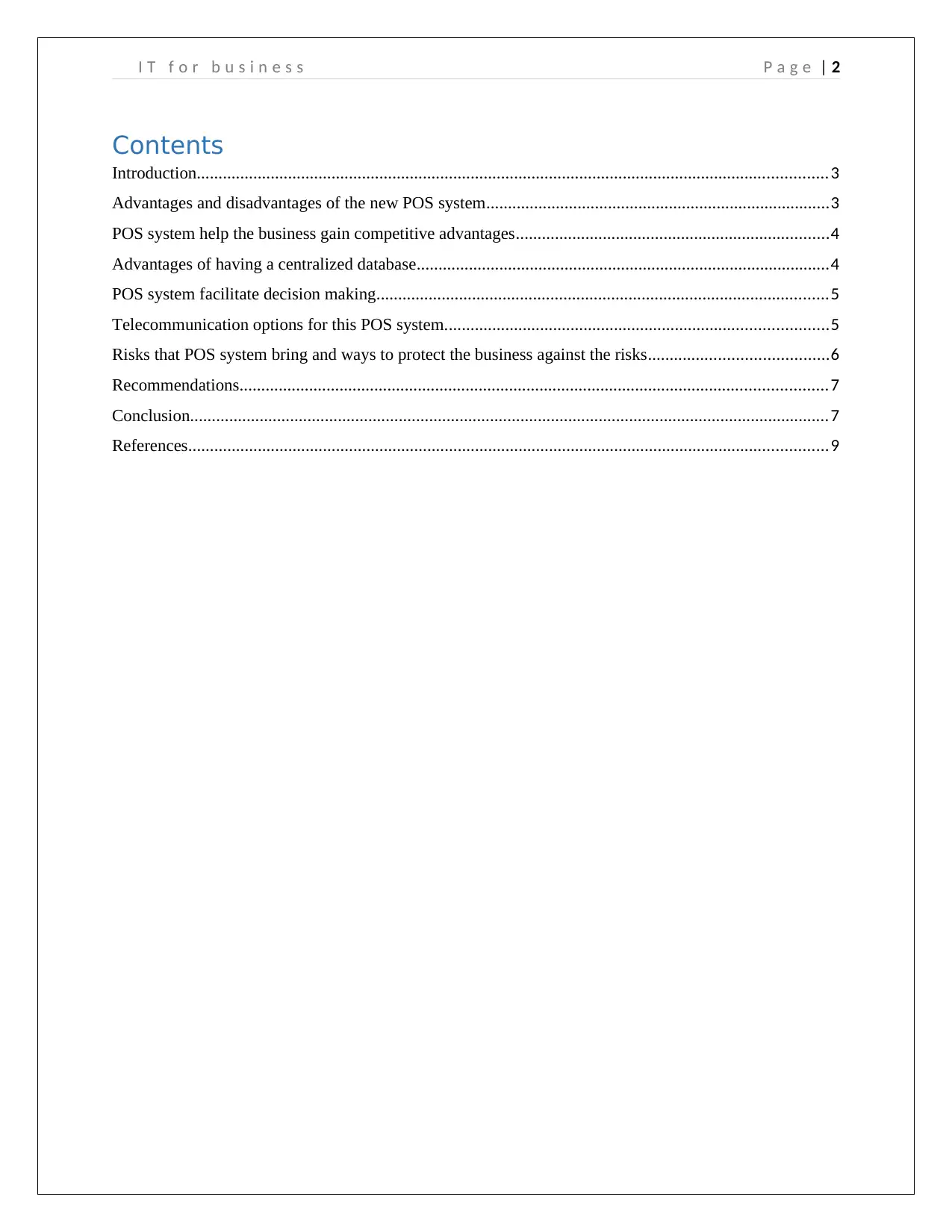
I T f o r b u s i n e s s P a g e | 2
Contents
Introduction.................................................................................................................................................3
Advantages and disadvantages of the new POS system...............................................................................3
POS system help the business gain competitive advantages........................................................................4
Advantages of having a centralized database...............................................................................................4
POS system facilitate decision making........................................................................................................5
Telecommunication options for this POS system........................................................................................5
Risks that POS system bring and ways to protect the business against the risks.........................................6
Recommendations.......................................................................................................................................7
Conclusion...................................................................................................................................................7
References...................................................................................................................................................9
Contents
Introduction.................................................................................................................................................3
Advantages and disadvantages of the new POS system...............................................................................3
POS system help the business gain competitive advantages........................................................................4
Advantages of having a centralized database...............................................................................................4
POS system facilitate decision making........................................................................................................5
Telecommunication options for this POS system........................................................................................5
Risks that POS system bring and ways to protect the business against the risks.........................................6
Recommendations.......................................................................................................................................7
Conclusion...................................................................................................................................................7
References...................................................................................................................................................9
⊘ This is a preview!⊘
Do you want full access?
Subscribe today to unlock all pages.

Trusted by 1+ million students worldwide
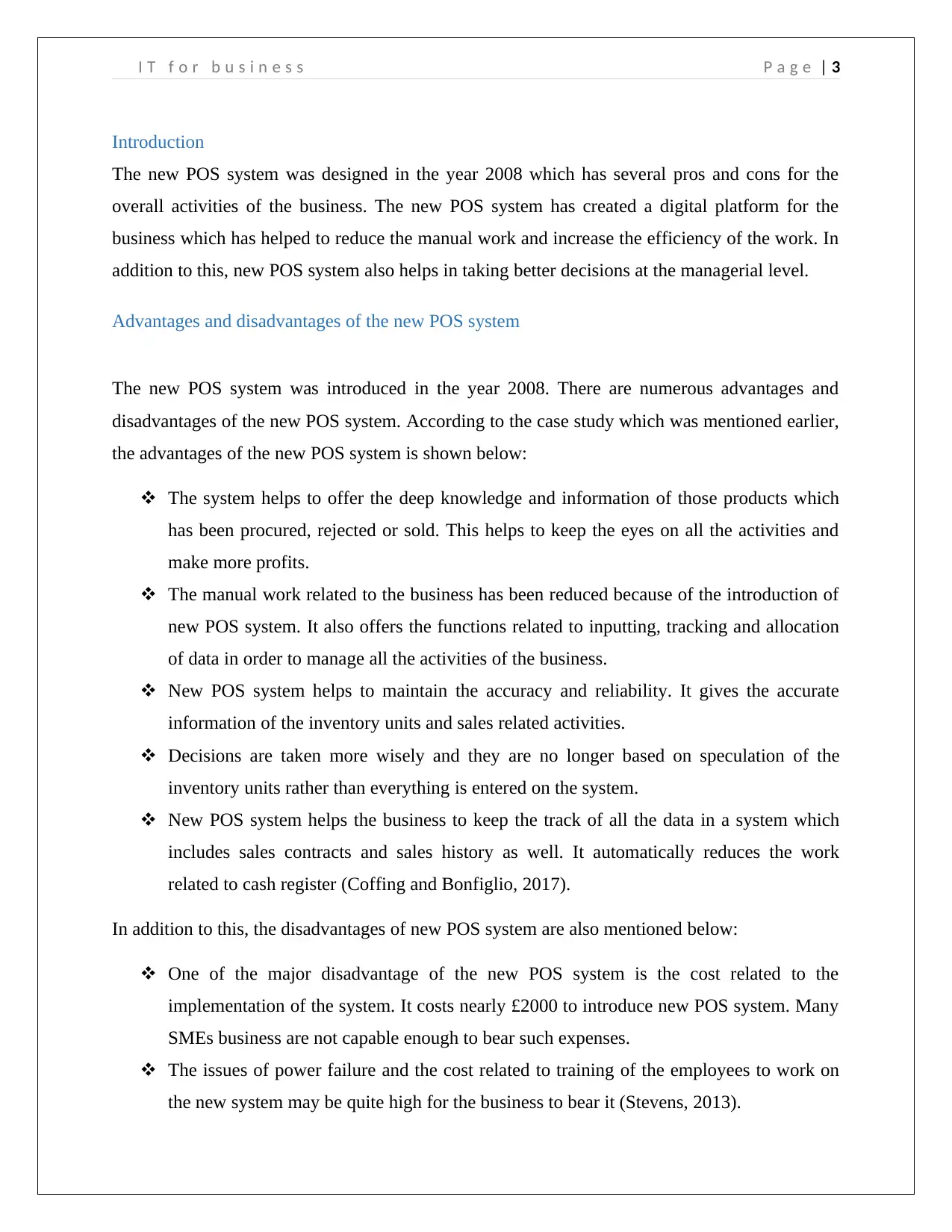
I T f o r b u s i n e s s P a g e | 3
Introduction
The new POS system was designed in the year 2008 which has several pros and cons for the
overall activities of the business. The new POS system has created a digital platform for the
business which has helped to reduce the manual work and increase the efficiency of the work. In
addition to this, new POS system also helps in taking better decisions at the managerial level.
Advantages and disadvantages of the new POS system
The new POS system was introduced in the year 2008. There are numerous advantages and
disadvantages of the new POS system. According to the case study which was mentioned earlier,
the advantages of the new POS system is shown below:
The system helps to offer the deep knowledge and information of those products which
has been procured, rejected or sold. This helps to keep the eyes on all the activities and
make more profits.
The manual work related to the business has been reduced because of the introduction of
new POS system. It also offers the functions related to inputting, tracking and allocation
of data in order to manage all the activities of the business.
New POS system helps to maintain the accuracy and reliability. It gives the accurate
information of the inventory units and sales related activities.
Decisions are taken more wisely and they are no longer based on speculation of the
inventory units rather than everything is entered on the system.
New POS system helps the business to keep the track of all the data in a system which
includes sales contracts and sales history as well. It automatically reduces the work
related to cash register (Coffing and Bonfiglio, 2017).
In addition to this, the disadvantages of new POS system are also mentioned below:
One of the major disadvantage of the new POS system is the cost related to the
implementation of the system. It costs nearly £2000 to introduce new POS system. Many
SMEs business are not capable enough to bear such expenses.
The issues of power failure and the cost related to training of the employees to work on
the new system may be quite high for the business to bear it (Stevens, 2013).
Introduction
The new POS system was designed in the year 2008 which has several pros and cons for the
overall activities of the business. The new POS system has created a digital platform for the
business which has helped to reduce the manual work and increase the efficiency of the work. In
addition to this, new POS system also helps in taking better decisions at the managerial level.
Advantages and disadvantages of the new POS system
The new POS system was introduced in the year 2008. There are numerous advantages and
disadvantages of the new POS system. According to the case study which was mentioned earlier,
the advantages of the new POS system is shown below:
The system helps to offer the deep knowledge and information of those products which
has been procured, rejected or sold. This helps to keep the eyes on all the activities and
make more profits.
The manual work related to the business has been reduced because of the introduction of
new POS system. It also offers the functions related to inputting, tracking and allocation
of data in order to manage all the activities of the business.
New POS system helps to maintain the accuracy and reliability. It gives the accurate
information of the inventory units and sales related activities.
Decisions are taken more wisely and they are no longer based on speculation of the
inventory units rather than everything is entered on the system.
New POS system helps the business to keep the track of all the data in a system which
includes sales contracts and sales history as well. It automatically reduces the work
related to cash register (Coffing and Bonfiglio, 2017).
In addition to this, the disadvantages of new POS system are also mentioned below:
One of the major disadvantage of the new POS system is the cost related to the
implementation of the system. It costs nearly £2000 to introduce new POS system. Many
SMEs business are not capable enough to bear such expenses.
The issues of power failure and the cost related to training of the employees to work on
the new system may be quite high for the business to bear it (Stevens, 2013).
Paraphrase This Document
Need a fresh take? Get an instant paraphrase of this document with our AI Paraphraser
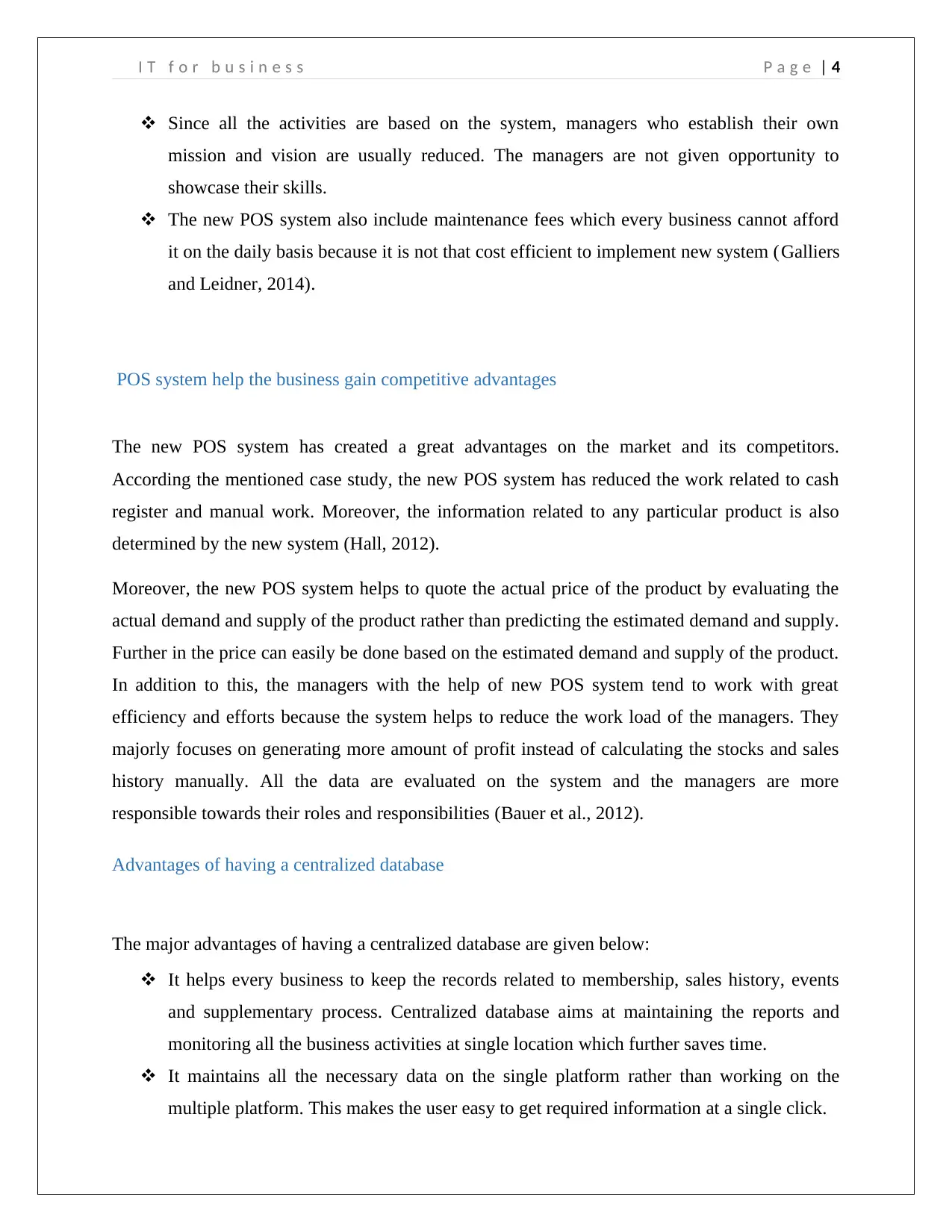
I T f o r b u s i n e s s P a g e | 4
Since all the activities are based on the system, managers who establish their own
mission and vision are usually reduced. The managers are not given opportunity to
showcase their skills.
The new POS system also include maintenance fees which every business cannot afford
it on the daily basis because it is not that cost efficient to implement new system (Galliers
and Leidner, 2014).
POS system help the business gain competitive advantages
The new POS system has created a great advantages on the market and its competitors.
According the mentioned case study, the new POS system has reduced the work related to cash
register and manual work. Moreover, the information related to any particular product is also
determined by the new system (Hall, 2012).
Moreover, the new POS system helps to quote the actual price of the product by evaluating the
actual demand and supply of the product rather than predicting the estimated demand and supply.
Further in the price can easily be done based on the estimated demand and supply of the product.
In addition to this, the managers with the help of new POS system tend to work with great
efficiency and efforts because the system helps to reduce the work load of the managers. They
majorly focuses on generating more amount of profit instead of calculating the stocks and sales
history manually. All the data are evaluated on the system and the managers are more
responsible towards their roles and responsibilities (Bauer et al., 2012).
Advantages of having a centralized database
The major advantages of having a centralized database are given below:
It helps every business to keep the records related to membership, sales history, events
and supplementary process. Centralized database aims at maintaining the reports and
monitoring all the business activities at single location which further saves time.
It maintains all the necessary data on the single platform rather than working on the
multiple platform. This makes the user easy to get required information at a single click.
Since all the activities are based on the system, managers who establish their own
mission and vision are usually reduced. The managers are not given opportunity to
showcase their skills.
The new POS system also include maintenance fees which every business cannot afford
it on the daily basis because it is not that cost efficient to implement new system (Galliers
and Leidner, 2014).
POS system help the business gain competitive advantages
The new POS system has created a great advantages on the market and its competitors.
According the mentioned case study, the new POS system has reduced the work related to cash
register and manual work. Moreover, the information related to any particular product is also
determined by the new system (Hall, 2012).
Moreover, the new POS system helps to quote the actual price of the product by evaluating the
actual demand and supply of the product rather than predicting the estimated demand and supply.
Further in the price can easily be done based on the estimated demand and supply of the product.
In addition to this, the managers with the help of new POS system tend to work with great
efficiency and efforts because the system helps to reduce the work load of the managers. They
majorly focuses on generating more amount of profit instead of calculating the stocks and sales
history manually. All the data are evaluated on the system and the managers are more
responsible towards their roles and responsibilities (Bauer et al., 2012).
Advantages of having a centralized database
The major advantages of having a centralized database are given below:
It helps every business to keep the records related to membership, sales history, events
and supplementary process. Centralized database aims at maintaining the reports and
monitoring all the business activities at single location which further saves time.
It maintains all the necessary data on the single platform rather than working on the
multiple platform. This makes the user easy to get required information at a single click.
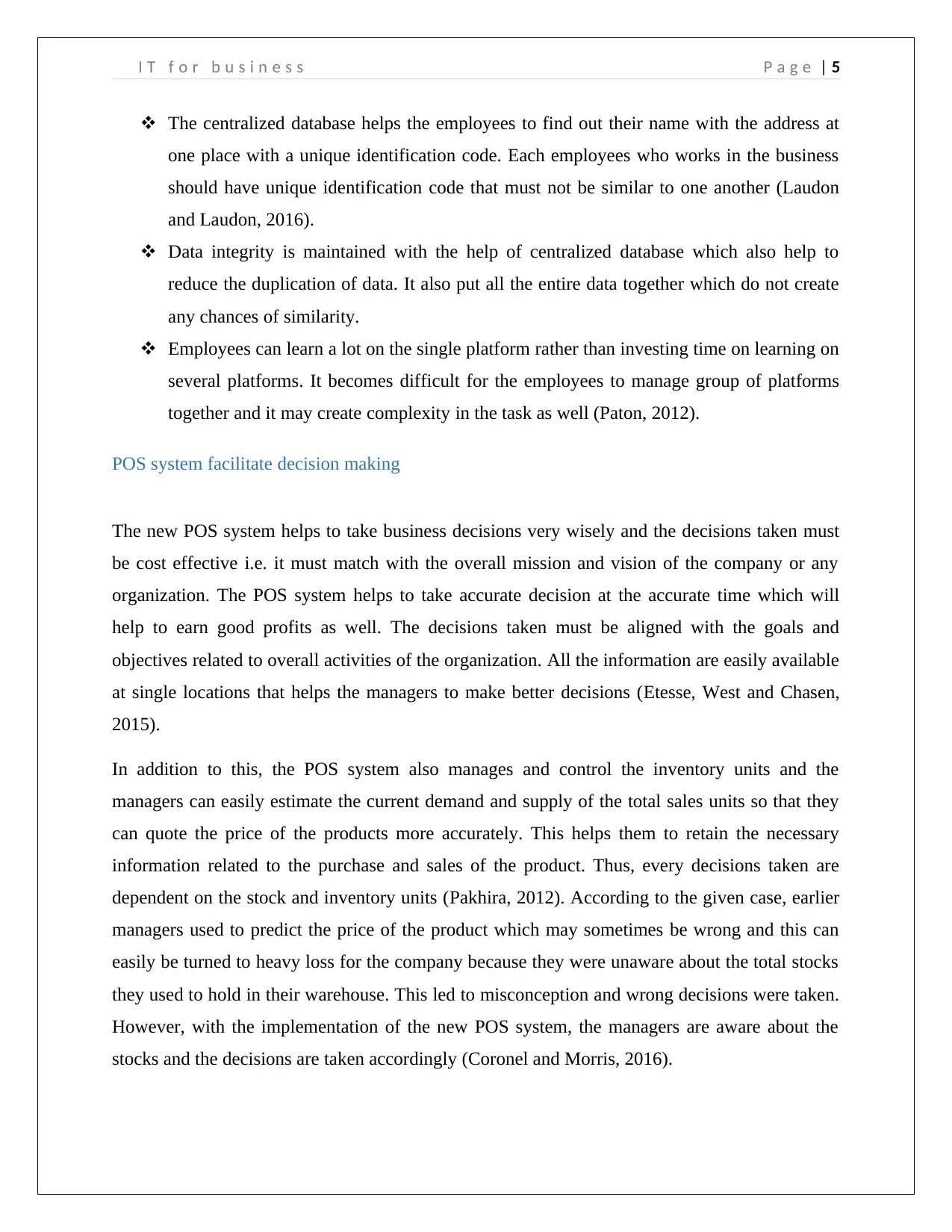
I T f o r b u s i n e s s P a g e | 5
The centralized database helps the employees to find out their name with the address at
one place with a unique identification code. Each employees who works in the business
should have unique identification code that must not be similar to one another (Laudon
and Laudon, 2016).
Data integrity is maintained with the help of centralized database which also help to
reduce the duplication of data. It also put all the entire data together which do not create
any chances of similarity.
Employees can learn a lot on the single platform rather than investing time on learning on
several platforms. It becomes difficult for the employees to manage group of platforms
together and it may create complexity in the task as well (Paton, 2012).
POS system facilitate decision making
The new POS system helps to take business decisions very wisely and the decisions taken must
be cost effective i.e. it must match with the overall mission and vision of the company or any
organization. The POS system helps to take accurate decision at the accurate time which will
help to earn good profits as well. The decisions taken must be aligned with the goals and
objectives related to overall activities of the organization. All the information are easily available
at single locations that helps the managers to make better decisions (Etesse, West and Chasen,
2015).
In addition to this, the POS system also manages and control the inventory units and the
managers can easily estimate the current demand and supply of the total sales units so that they
can quote the price of the products more accurately. This helps them to retain the necessary
information related to the purchase and sales of the product. Thus, every decisions taken are
dependent on the stock and inventory units (Pakhira, 2012). According to the given case, earlier
managers used to predict the price of the product which may sometimes be wrong and this can
easily be turned to heavy loss for the company because they were unaware about the total stocks
they used to hold in their warehouse. This led to misconception and wrong decisions were taken.
However, with the implementation of the new POS system, the managers are aware about the
stocks and the decisions are taken accordingly (Coronel and Morris, 2016).
The centralized database helps the employees to find out their name with the address at
one place with a unique identification code. Each employees who works in the business
should have unique identification code that must not be similar to one another (Laudon
and Laudon, 2016).
Data integrity is maintained with the help of centralized database which also help to
reduce the duplication of data. It also put all the entire data together which do not create
any chances of similarity.
Employees can learn a lot on the single platform rather than investing time on learning on
several platforms. It becomes difficult for the employees to manage group of platforms
together and it may create complexity in the task as well (Paton, 2012).
POS system facilitate decision making
The new POS system helps to take business decisions very wisely and the decisions taken must
be cost effective i.e. it must match with the overall mission and vision of the company or any
organization. The POS system helps to take accurate decision at the accurate time which will
help to earn good profits as well. The decisions taken must be aligned with the goals and
objectives related to overall activities of the organization. All the information are easily available
at single locations that helps the managers to make better decisions (Etesse, West and Chasen,
2015).
In addition to this, the POS system also manages and control the inventory units and the
managers can easily estimate the current demand and supply of the total sales units so that they
can quote the price of the products more accurately. This helps them to retain the necessary
information related to the purchase and sales of the product. Thus, every decisions taken are
dependent on the stock and inventory units (Pakhira, 2012). According to the given case, earlier
managers used to predict the price of the product which may sometimes be wrong and this can
easily be turned to heavy loss for the company because they were unaware about the total stocks
they used to hold in their warehouse. This led to misconception and wrong decisions were taken.
However, with the implementation of the new POS system, the managers are aware about the
stocks and the decisions are taken accordingly (Coronel and Morris, 2016).
⊘ This is a preview!⊘
Do you want full access?
Subscribe today to unlock all pages.

Trusted by 1+ million students worldwide
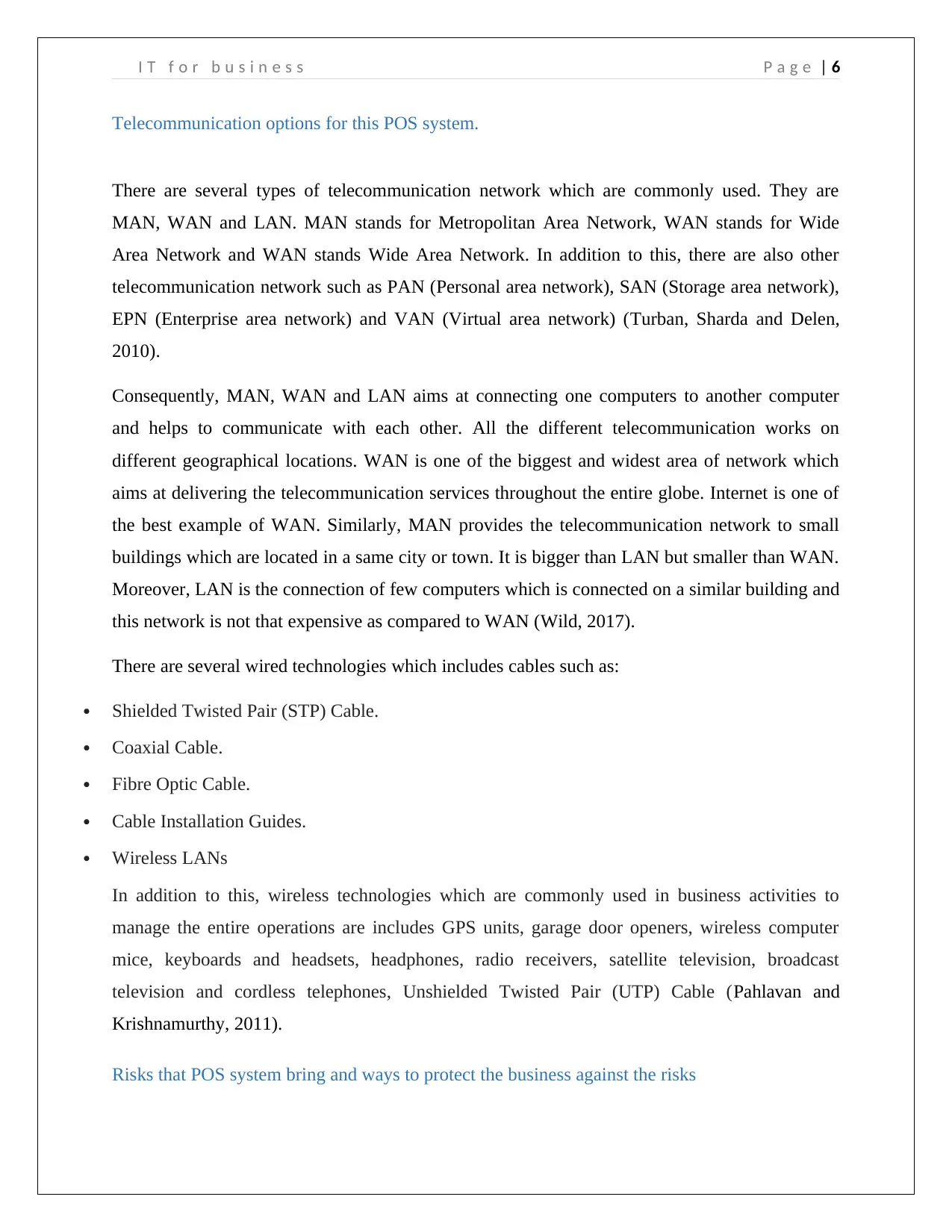
I T f o r b u s i n e s s P a g e | 6
Telecommunication options for this POS system.
There are several types of telecommunication network which are commonly used. They are
MAN, WAN and LAN. MAN stands for Metropolitan Area Network, WAN stands for Wide
Area Network and WAN stands Wide Area Network. In addition to this, there are also other
telecommunication network such as PAN (Personal area network), SAN (Storage area network),
EPN (Enterprise area network) and VAN (Virtual area network) (Turban, Sharda and Delen,
2010).
Consequently, MAN, WAN and LAN aims at connecting one computers to another computer
and helps to communicate with each other. All the different telecommunication works on
different geographical locations. WAN is one of the biggest and widest area of network which
aims at delivering the telecommunication services throughout the entire globe. Internet is one of
the best example of WAN. Similarly, MAN provides the telecommunication network to small
buildings which are located in a same city or town. It is bigger than LAN but smaller than WAN.
Moreover, LAN is the connection of few computers which is connected on a similar building and
this network is not that expensive as compared to WAN (Wild, 2017).
There are several wired technologies which includes cables such as:
Shielded Twisted Pair (STP) Cable.
Coaxial Cable.
Fibre Optic Cable.
Cable Installation Guides.
Wireless LANs
In addition to this, wireless technologies which are commonly used in business activities to
manage the entire operations are includes GPS units, garage door openers, wireless computer
mice, keyboards and headsets, headphones, radio receivers, satellite television, broadcast
television and cordless telephones, Unshielded Twisted Pair (UTP) Cable (Pahlavan and
Krishnamurthy, 2011).
Risks that POS system bring and ways to protect the business against the risks
Telecommunication options for this POS system.
There are several types of telecommunication network which are commonly used. They are
MAN, WAN and LAN. MAN stands for Metropolitan Area Network, WAN stands for Wide
Area Network and WAN stands Wide Area Network. In addition to this, there are also other
telecommunication network such as PAN (Personal area network), SAN (Storage area network),
EPN (Enterprise area network) and VAN (Virtual area network) (Turban, Sharda and Delen,
2010).
Consequently, MAN, WAN and LAN aims at connecting one computers to another computer
and helps to communicate with each other. All the different telecommunication works on
different geographical locations. WAN is one of the biggest and widest area of network which
aims at delivering the telecommunication services throughout the entire globe. Internet is one of
the best example of WAN. Similarly, MAN provides the telecommunication network to small
buildings which are located in a same city or town. It is bigger than LAN but smaller than WAN.
Moreover, LAN is the connection of few computers which is connected on a similar building and
this network is not that expensive as compared to WAN (Wild, 2017).
There are several wired technologies which includes cables such as:
Shielded Twisted Pair (STP) Cable.
Coaxial Cable.
Fibre Optic Cable.
Cable Installation Guides.
Wireless LANs
In addition to this, wireless technologies which are commonly used in business activities to
manage the entire operations are includes GPS units, garage door openers, wireless computer
mice, keyboards and headsets, headphones, radio receivers, satellite television, broadcast
television and cordless telephones, Unshielded Twisted Pair (UTP) Cable (Pahlavan and
Krishnamurthy, 2011).
Risks that POS system bring and ways to protect the business against the risks
Paraphrase This Document
Need a fresh take? Get an instant paraphrase of this document with our AI Paraphraser
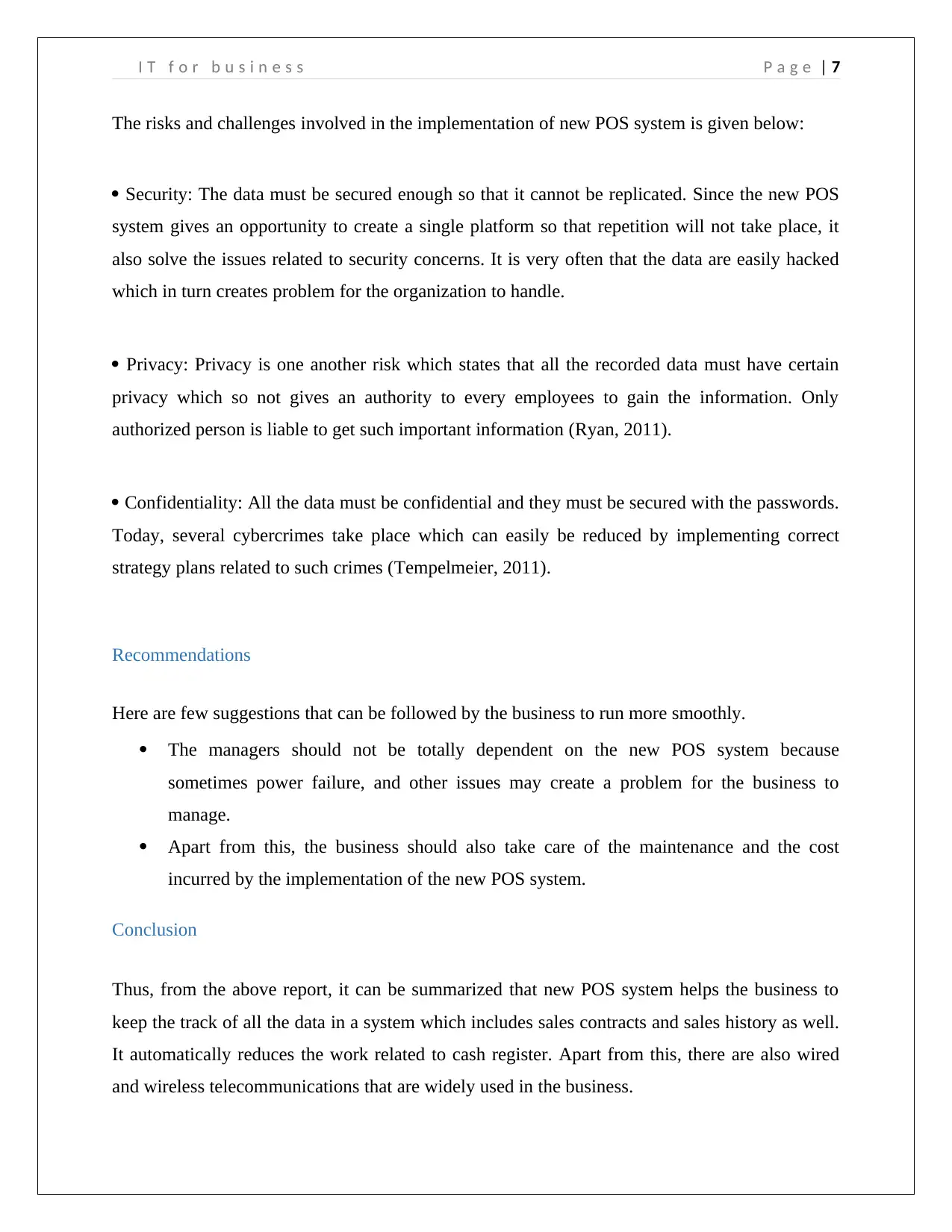
I T f o r b u s i n e s s P a g e | 7
The risks and challenges involved in the implementation of new POS system is given below:
Security: The data must be secured enough so that it cannot be replicated. Since the new POS
system gives an opportunity to create a single platform so that repetition will not take place, it
also solve the issues related to security concerns. It is very often that the data are easily hacked
which in turn creates problem for the organization to handle.
Privacy: Privacy is one another risk which states that all the recorded data must have certain
privacy which so not gives an authority to every employees to gain the information. Only
authorized person is liable to get such important information (Ryan, 2011).
Confidentiality: All the data must be confidential and they must be secured with the passwords.
Today, several cybercrimes take place which can easily be reduced by implementing correct
strategy plans related to such crimes (Tempelmeier, 2011).
Recommendations
Here are few suggestions that can be followed by the business to run more smoothly.
The managers should not be totally dependent on the new POS system because
sometimes power failure, and other issues may create a problem for the business to
manage.
Apart from this, the business should also take care of the maintenance and the cost
incurred by the implementation of the new POS system.
Conclusion
Thus, from the above report, it can be summarized that new POS system helps the business to
keep the track of all the data in a system which includes sales contracts and sales history as well.
It automatically reduces the work related to cash register. Apart from this, there are also wired
and wireless telecommunications that are widely used in the business.
The risks and challenges involved in the implementation of new POS system is given below:
Security: The data must be secured enough so that it cannot be replicated. Since the new POS
system gives an opportunity to create a single platform so that repetition will not take place, it
also solve the issues related to security concerns. It is very often that the data are easily hacked
which in turn creates problem for the organization to handle.
Privacy: Privacy is one another risk which states that all the recorded data must have certain
privacy which so not gives an authority to every employees to gain the information. Only
authorized person is liable to get such important information (Ryan, 2011).
Confidentiality: All the data must be confidential and they must be secured with the passwords.
Today, several cybercrimes take place which can easily be reduced by implementing correct
strategy plans related to such crimes (Tempelmeier, 2011).
Recommendations
Here are few suggestions that can be followed by the business to run more smoothly.
The managers should not be totally dependent on the new POS system because
sometimes power failure, and other issues may create a problem for the business to
manage.
Apart from this, the business should also take care of the maintenance and the cost
incurred by the implementation of the new POS system.
Conclusion
Thus, from the above report, it can be summarized that new POS system helps the business to
keep the track of all the data in a system which includes sales contracts and sales history as well.
It automatically reduces the work related to cash register. Apart from this, there are also wired
and wireless telecommunications that are widely used in the business.

I T f o r b u s i n e s s P a g e | 8
⊘ This is a preview!⊘
Do you want full access?
Subscribe today to unlock all pages.

Trusted by 1+ million students worldwide
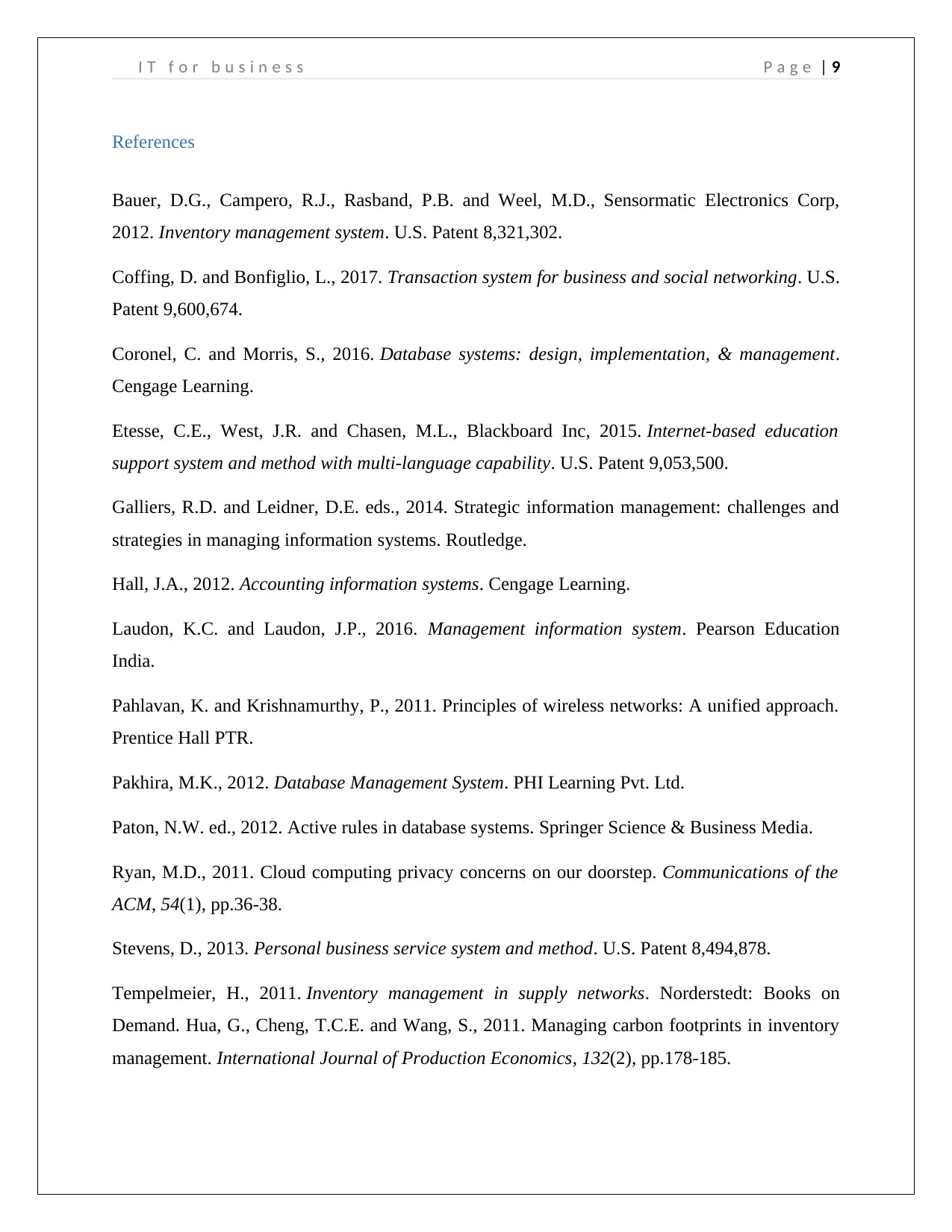
I T f o r b u s i n e s s P a g e | 9
References
Bauer, D.G., Campero, R.J., Rasband, P.B. and Weel, M.D., Sensormatic Electronics Corp,
2012. Inventory management system. U.S. Patent 8,321,302.
Coffing, D. and Bonfiglio, L., 2017. Transaction system for business and social networking. U.S.
Patent 9,600,674.
Coronel, C. and Morris, S., 2016. Database systems: design, implementation, & management.
Cengage Learning.
Etesse, C.E., West, J.R. and Chasen, M.L., Blackboard Inc, 2015. Internet-based education
support system and method with multi-language capability. U.S. Patent 9,053,500.
Galliers, R.D. and Leidner, D.E. eds., 2014. Strategic information management: challenges and
strategies in managing information systems. Routledge.
Hall, J.A., 2012. Accounting information systems. Cengage Learning.
Laudon, K.C. and Laudon, J.P., 2016. Management information system. Pearson Education
India.
Pahlavan, K. and Krishnamurthy, P., 2011. Principles of wireless networks: A unified approach.
Prentice Hall PTR.
Pakhira, M.K., 2012. Database Management System. PHI Learning Pvt. Ltd.
Paton, N.W. ed., 2012. Active rules in database systems. Springer Science & Business Media.
Ryan, M.D., 2011. Cloud computing privacy concerns on our doorstep. Communications of the
ACM, 54(1), pp.36-38.
Stevens, D., 2013. Personal business service system and method. U.S. Patent 8,494,878.
Tempelmeier, H., 2011. Inventory management in supply networks. Norderstedt: Books on
Demand. Hua, G., Cheng, T.C.E. and Wang, S., 2011. Managing carbon footprints in inventory
management. International Journal of Production Economics, 132(2), pp.178-185.
References
Bauer, D.G., Campero, R.J., Rasband, P.B. and Weel, M.D., Sensormatic Electronics Corp,
2012. Inventory management system. U.S. Patent 8,321,302.
Coffing, D. and Bonfiglio, L., 2017. Transaction system for business and social networking. U.S.
Patent 9,600,674.
Coronel, C. and Morris, S., 2016. Database systems: design, implementation, & management.
Cengage Learning.
Etesse, C.E., West, J.R. and Chasen, M.L., Blackboard Inc, 2015. Internet-based education
support system and method with multi-language capability. U.S. Patent 9,053,500.
Galliers, R.D. and Leidner, D.E. eds., 2014. Strategic information management: challenges and
strategies in managing information systems. Routledge.
Hall, J.A., 2012. Accounting information systems. Cengage Learning.
Laudon, K.C. and Laudon, J.P., 2016. Management information system. Pearson Education
India.
Pahlavan, K. and Krishnamurthy, P., 2011. Principles of wireless networks: A unified approach.
Prentice Hall PTR.
Pakhira, M.K., 2012. Database Management System. PHI Learning Pvt. Ltd.
Paton, N.W. ed., 2012. Active rules in database systems. Springer Science & Business Media.
Ryan, M.D., 2011. Cloud computing privacy concerns on our doorstep. Communications of the
ACM, 54(1), pp.36-38.
Stevens, D., 2013. Personal business service system and method. U.S. Patent 8,494,878.
Tempelmeier, H., 2011. Inventory management in supply networks. Norderstedt: Books on
Demand. Hua, G., Cheng, T.C.E. and Wang, S., 2011. Managing carbon footprints in inventory
management. International Journal of Production Economics, 132(2), pp.178-185.
Paraphrase This Document
Need a fresh take? Get an instant paraphrase of this document with our AI Paraphraser

I T f o r b u s i n e s s P a g e | 10
Turban, E., Sharda, R. and Delen, D., 2010. Decision Support and Business Intelligence Systems
(required). Prentice Hall Learning Outcomes.
Wild, T., 2017. Best practice in inventory management. Routledge.
Turban, E., Sharda, R. and Delen, D., 2010. Decision Support and Business Intelligence Systems
(required). Prentice Hall Learning Outcomes.
Wild, T., 2017. Best practice in inventory management. Routledge.
1 out of 11
Related Documents
Your All-in-One AI-Powered Toolkit for Academic Success.
+13062052269
info@desklib.com
Available 24*7 on WhatsApp / Email
![[object Object]](/_next/static/media/star-bottom.7253800d.svg)
Unlock your academic potential
Copyright © 2020–2025 A2Z Services. All Rights Reserved. Developed and managed by ZUCOL.




